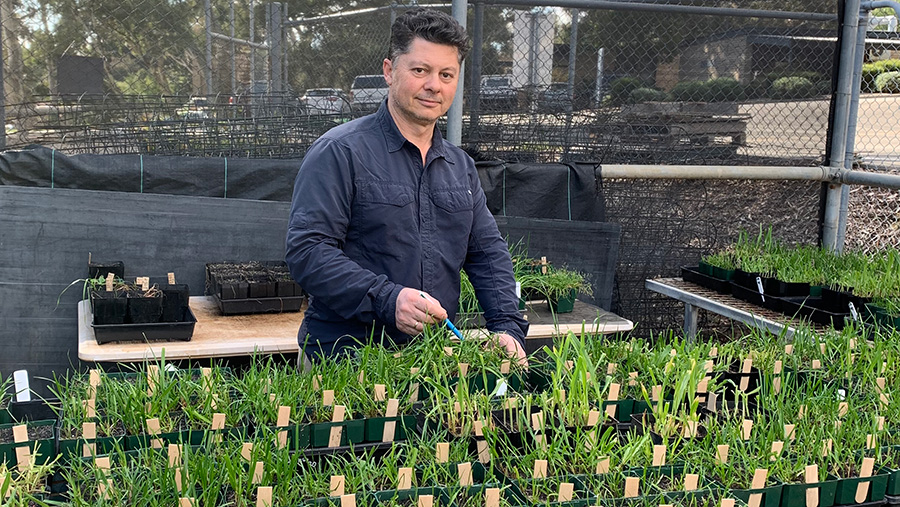Key points
- Spring means annual ryegrass will be flowering or setting seed
- Be on the lookout and have weeds tested to boost the chances of using the most effective herbicides or tactics
- Ryegrass is the number one cropping weed in Australia and is spreading northwards
Growers are being asked to look out for a hairless, bright green, narrow-leaf weed – annual ryegrass – that is increasingly appearing in northern New South Wales and southern Queensland.
In September and October, annual ryegrass will likely be flowering or setting seed.
Paul McIntosh, the northern region industry development agronomist for WeedSmart, warns that annual ryegrass has the potential to be as bad as feathertop Rhodes grass and fleabane. “This plant is not just another weed. There are concerns about herbicide resistance,” Mr McIntosh says.
Garry Onus, a senior agronomist with Nutrien Ag Solutions in Moree, agrees and says it is reasonable to assume that annual ryegrass will have some herbicide resistance, given the experience in southern and western grain regions. He recommends getting the plant or its seed tested to have best chance of eradicating small areas using herbicides that will work on that population.
Samples can be sent to one of the following:
- Plant Science Consulting;
- Charles Sturt University, Herbicide Resistance, Gulbali Institute; or
- Australian Herbicide Resistance Initiative, herbicide resistance testing.
Dr Michael Thompson, GRDC crop protection manager – north – says it is important to know which herbicide a ryegrass population is resistant to. “It can help determine the chemical control options. For example, growers can opt for incorporating different modes of action (MOA) that the ryegrass is still susceptible to, as well as plan to rotate the available MOAs to help prevent further development of resistance.”
Dr Thompson says being aware of annual ryegrass is the first step. “It is the number one weed in Australia. This is not the case in the north yet and we want to keep it that way.”
It is also important to note that other non-chemical control tactics such as increasing crop competition can be considered, he says.
Mr McIntosh agrees and says weed management tactics familiar to most growers can be employed.
“Use all facets of area-wide management, especially around adjacent roadsides, gullies and creeks and fencelines, and implement an effective clean down of machinery and contractors,” he says.
Look to WeedSmart’s Big 6 here.
Why is annual ryegrass now a problem?
Over the past few seasons, annual ryegrass has appeared in northern NSW and southern Queensland.
Paul McIntosh, the northern region industry development agronomist for WeedSmart, says hay brought into southern Queensland in the 2019–21 drought unfortunately carried annual ryegrass plants or had mature seeds on stalks.
While this certainly contributed, herbicide resistance specialist Dr Peter Boutsalis from the University of Adelaide and Plant Science Consulting says it will also have come from unclean seed.
“It has been selected for very slowly. You can have one seed in a kilo of seed and that’s enough for resistance to spread.”
What herbicides is annual ryegrass resistant to?
The University of Adelaide’s Dr Peter Boutsalis has been conducting random weed surveys for almost 20 years, monitoring changes in herbicide resistance.
His 2020 results for the northern part of the GRDC’s northern region – from Goondiwindi up – show which herbicides annual ryegrass is becoming resistant to.
Dr Boutsalis uses random weed surveys and client samples. Random weed surveys occur when he and his team gain access to cropped paddocks, choose a random spot, and take and test samples.
Client samples are weeds or seed sent to him by agronomists or growers for testing. These results generally show higher levels of resistance because they have already been identified as suspicious.
These are the 2020 results:
- Axial® (cloquintocet and pinoxaden) – used in-crop to control ryegrass in wheat
- Random weed surveys showed 28% resistance
- Client results showed 76% resistance
- Clethodim – used to control ryegrass in broadleaf crops
- Random weed surveys showed 6% resistance
- Client results showed 22% resistance
- Imazapic – used in Clearfield® crops and in summer fallow
- Random weed surveys showed 26% resistance
- Client results showed 60% resistance
- Hussar® (iodosulfuron and mefenpyr)
- Random weed surveys showed 47% resistance
- Client results showed 76% resistance
- Glyphosate
- Random weed surveys showed 16% resistance
- Client results showed 34% resistance.

Dr Peter Boutsalis has been conducting random weed surveys for almost 20 years, monitoring changes in herbicide resistance. Photo: supplied by Peter Boutsalis
So far, annual ryegrass is not showing resistance to paraquat in the northern part of the northern region but resistance has been detected in Western Australia, South Australia, Victoria and southern New South Wales.
Dr Boutsalis suggests mixing it with Terrad’or® (tiafenacil) or Voraxor® (saflufenacil and trifludimoxazin) and not over-relying on its sole use.
Glyphosate can also be mixed with Voraxor®. “This won’t control glyphosate-resistant ryegrass but it kills faster so it will stop the selection of glyphosate-resistant weeds.”
These results will be updated in 2025 with surveys being undertaken this year by Michael Widderick at Queensland Department of Agriculture and Fisheries as part of the GRDC research project UCS2008-001RTX.

























































